
Truly great inventors can see problems where you or I wouldn't. Consider the humble baseball cap. It hasn't changed much in decades, and it hasn't needed to; its functionality, comfort, and versatility lends itself to all kinds of athletic activity, such as playing baseball, spouting monosyllabic platitudes at post-game press conferences until your team's PR guy says you go catch the shuttle to the Gold Club, and... some sort of competitive Ashton Kutcher impersonation circuit, probably. It keeps the sun out of your eyes, and in the offseason can serve as a tent for an outdoor wedding of up to 190 people (Barry Bonds only). It's perfect, right?
Wrong! The average baseball cap is a nightmarish, seething, head-mounted sack of deficiencies, with a team logo on it.
Welcome to Patentspin. I'll use this space to take a look at some strange or interesting patents related to the world of sports. I will then, probably, make fun of them.
35 USC § 101, the first section of American patent law, reads as follows (emphasis added):
"Whoever invents or discovers any new and useful process, machine, manufacture, or composition of matter, or any new and useful improvement thereof, may obtain a patent therefor, subject to the conditions and requirements of this title."
"New" is relatively self-explanatory, but "useful" sounds a little more subjective. The Manual for Patent Examination Procedure explains it in more detail:
(i) A claimed invention must have a specific and substantial utility. This requirement excludes “throw-away,” “insubstantial,” or “nonspecific” utilities, such as the use of a complex invention as landfill, as a way of satisfying the utility requirement of 35 U.S.C. 101.
Now, the upshot is that this isn't a particularly difficult hurdle for most aspiring patent-holders to clear, but they still have to explain, in the patent application, why their invention is useful. What's the problem your invention is meant to solve? Sometimes, it's a legitimate problem, such as existing "sports bras" being terrible. Other times, it's that footballs can't be thrown far enough because they lack miniaturized combustion engines. In any case, the inventor must demonstrate that there is a problem, however exaggerated, and explain how their invention solves it.
Below are a few examples of brave souls who have seen the light and attempted to remedy the fundamental defects that have plagued the baseball cap since its inception.
Because baseball caps are like airplanes
Problem #1: Moving air blows the baseball cap off of the wearer's head, onto the baseball field, or into the lake, or out of the biplane, or what have you.
Skeptical? Let this diagram convince you:
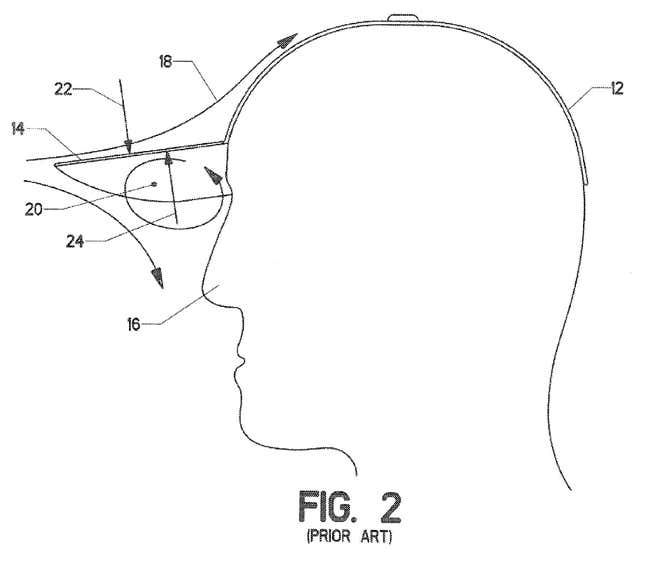
That's a person wearing a regular baseball cap. Notice the little circle under the brim. According to the inventor, this is... well, I'll let him explain it:
The flow passing under the bill, however, impacts the wearer's face 16. This produces a recirculation area denoted as stagnation region 20. The flow in this area is relatively slow. Thus, from Bernoulli's equation, one may accurately predict that the air pressure in the area beneath the bill will be greater than the air pressure in the area above the bill. The result is the creation of lift 24, which tends to lift the cap free of the wearer's head.
Damnit, Bernoulli. Not only does your Principle allow airplanes to fly, it also knocks my cap off when I play baseball in a wind tunnel, by creating a high-pressure, miniature face tornado (or "stagnation region," if you're boring) under the brim.
A cap being blown off a player's head during a baseball game, obviously, has some positive attributes: it demonstrates a player's scrappiness, grit, and hustle, in a way only matched by "ECKSTEIN" being inscribed on the back of a tiny, tiny jersey. However, in other situations, it's clear how this could be a bad thing. How do we battle the tiny tornado hiding under one's cap?
Solution: Wind-Stabilized Baseball Cap - U.S. Patent Application No. 2013/0239292
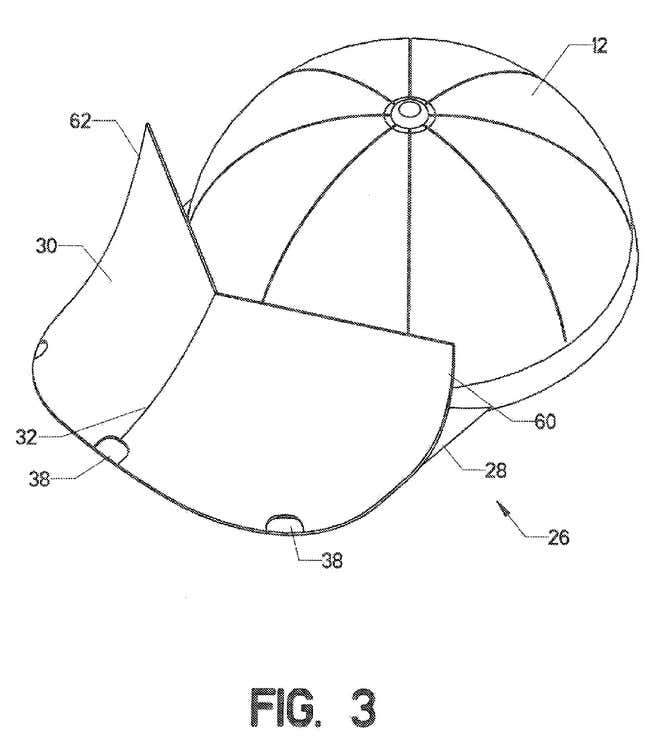
Well, that's certainly one way.
FIG. 3 shows the present invention in an assembled state. Stay-on cap 26 has modified bill 28. Downforce generator 30 is preferably attached to modified bill 28. The reader will observe how the downforce generator preferably assumes a form reminiscent of a snow plow blade. Splitter 32 preferably lies near the middle of the downforce generator. Air flow impacting the downforce generator strikes the splitter and is thereafter divided into a first portion directed toward a first lateral extreme 60 and a second portion directed toward a second lateral extreme 62.
So, the snowplow doohickey, in addition to being stylish as hell, uses some of the lateral air force to push the brim down. Makes sense, but what about that evil mini-tornado?
FIG. 4 shows the same assembly in an exploded state.
Yes! Finally, some action!

Not half as cool as the word "exploded" led me to believe it would be, but the little snowplow was apparently hiding some sort of vent. What is it doing there?
The geometry of the vent, the flap, the cap, and the downforce generator combine to selectively create (1) a first state in which the flap opens to allow flow through the bill when needed to keep the hat in place; and (2) a second state in which the flap is forced closed in order to restore the normal functions of the bill. The automatic transfer between these two states is referred to as “active load relief,” meaning that the cap automatically changes its configuration in order to hold the cap in position on the wearer's head.
Emphasis added to show what that little flap is doing: opening and closing in response to miniature face tornadoes. Let's get a little side-by-side action going:
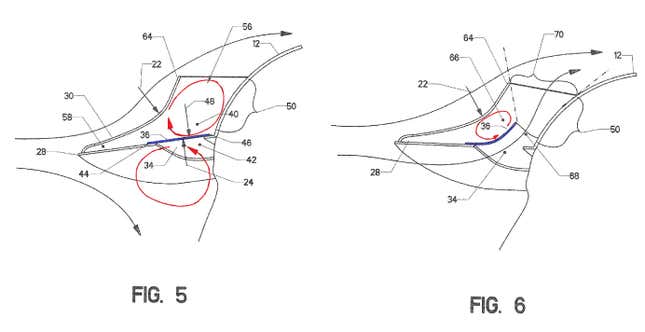
On the left side, we have a player in motion. The gap (56) behind the snowplow device (22) creates an air pocket in which another miniature tornado (colored in red) is formed. This raises the air pressure above the brim, matching the raised air pressure created by the miniature face tornado. As there's no air pressure difference, because the air pressure is high on both sides, there's no lift. Brilliant!
The right side, however, shows the same baseball player, who has since moved to a speedboat, wearing his same baseball cap, and tilting his head upwards. He may not be the smartest guy, but he batted .785 his senior year of high school, so the fact that he didn't quite "get" physics hasn't really been an issue for him up until this point in his life. Anyway, there's still a stagnation region on top, but the flap is opened by the air pushing on it. The air is moving rapidly underneath the brim, lowering the pressure; the net result of the high pressure above the brim and the low pressure below is that instead of being blown away into the water, the hat is pushed down onto the head. Also brilliant! I take back those mean things I said about you, Bernoulli.
Wind-hat solved. What's next?
Because your baseball cap is cooking your brain
Problem #2: Baseball caps are too hot.
Fair enough. A hat is generally sitting on top of your greasy hair (or greasy scalp), baking in the hot sun, which is why they get so disgusting and need to be baptized in Pine Sol, or bleach, or holy water in very extreme cases. But what if there were a better way?
Solution: Utilizing an Airfoil Effect for Inducing Cooling in a Baseball Cap, a.k.a. ”Air Cap” - U.S. Patent Application Publication No. 2012/0000006
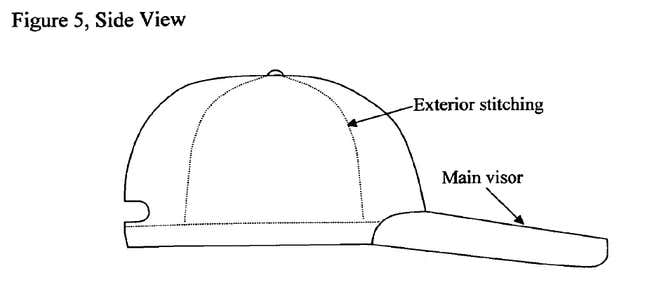
....................it's a hat. Terrific.
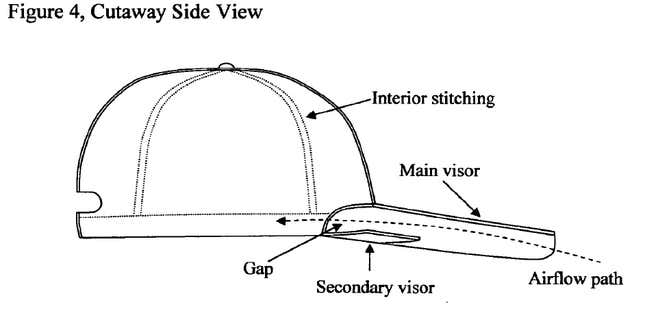
Oh! I stand corrected: It's a hat with a dark secret. Or a hat with a second hidden visor that creates a channel into which air can flow. It seems reasonably straightforward: air can flow into that gap (which doesn't exist in primitive, single-visored baseball caps), cooling one's head. Is it that simple? Of course not:
The Air Cap is constructed to create an airfoil shape out of the visor. According to aerodynamic principles, air flowing over the top curve of an airfoil has a longer distance to travel and therefore must move faster than the air travelling under the airfoil. This principle is what creates lift in a wing.
In the space of only a few short paragraphs, the baseball cap-makers of the world have learned to harness the powers of Bernoulli for good. Science!
By constructing an Air Cap with a normal-sized main visor or bill in the front with the main bill deliberately curved upwards where it is attached to the cap, the main bill becomes the top of curve of an airfoil shape (FIG. 1). Placing a short, flat, second bill underneath the main bill where the bill meets a wearer's head will create the bottom of an airfoil shape (FIG. 2).
Let's see that airfoil shape:

The way in which the average wearer of this hat will get the most airflow over his head, of course, will come from removing it from his head every few minutes to show somebody his cool, dual-visored, Bernoulli-harnessing hat. Such is the life of the early adopter. The inventors of this "Air Cap" have been granted a patent already, and the inventors of the wind-stabilized hat look like they're about to be granted one soon, so, good for both of them. What other problem is there to solve?
WOMEN!!! AM I RIGHT???
Problem #3: Baseball caps are too masculine.
That's...that's not an actual probl—
Solution: Feminized Baseball Caps - U.S. Patent Application Publication No. 2013/0042388
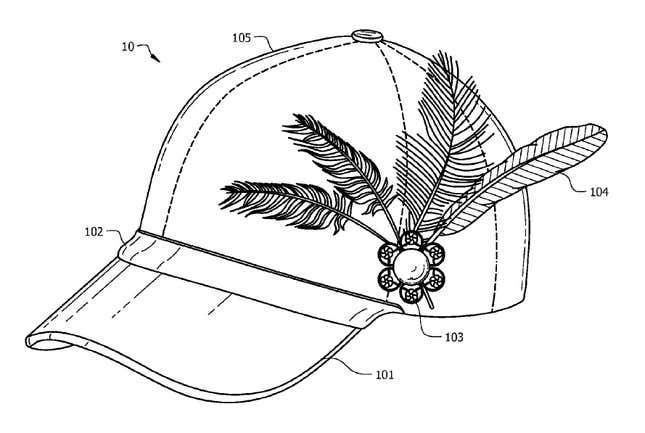
Jesus Christ. Fine, inventors, what's the problem with women wearing normal baseball caps?
Headwear of various styles and shapes have for some time been worn for protection. For example, headwear may be part of a uniform worn for a particular athletic activity, such as baseball. This headwear often worn in athletic activities may be comfortable and provide protection from the weather or the sun; however, such headwear generally has not been desirable for many women to wear when they are not engaging in athletic activity.
Really? Have you been under a rock since 2004?

I suppose, after last year's World Series, you could combine the two and enjoy the symbolism of putting a Cardinal feather in your Red Sox cap. What say you, Claim 7?
7. The feminized baseball cap of claim 1, wherein said at least one feather is selected from the group comprising:
hackle feathers, ostrich feathers, guinea feathers, pheasant feathers, peacock feathers, rooster feathers, and synthetic feathers.
No cardinal feathers. What a missed opportunity. Anyway, this application might not result in a patent; this looks more an issue of style than usefulness. It's for the best, though, as this hat is unnecessary.
Oh, just do whatever you want.
Problems 1, 2, and 3: Your hat is lifted up by the wind, isn't cool, and is too masculine.
Grand solution: Baseball Cap with Rear Spoiler - U.S. Design Patent No. D556,428
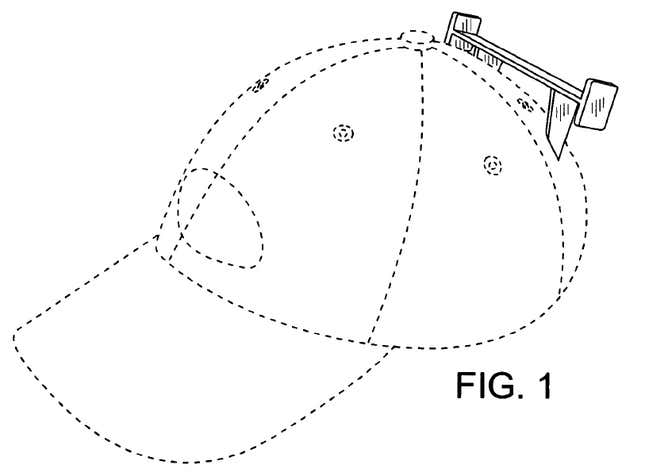
Game...
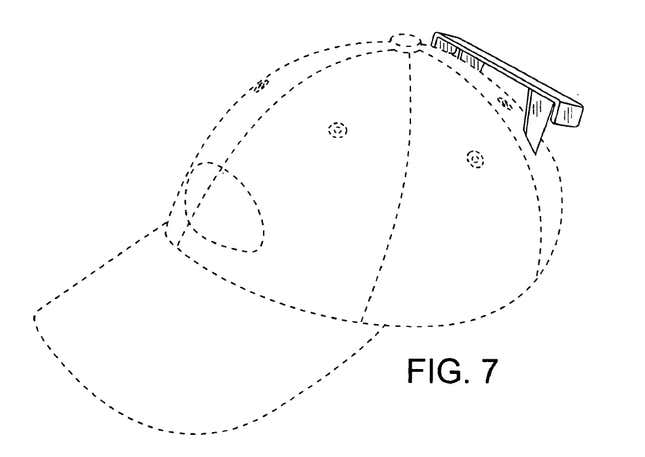
...set...
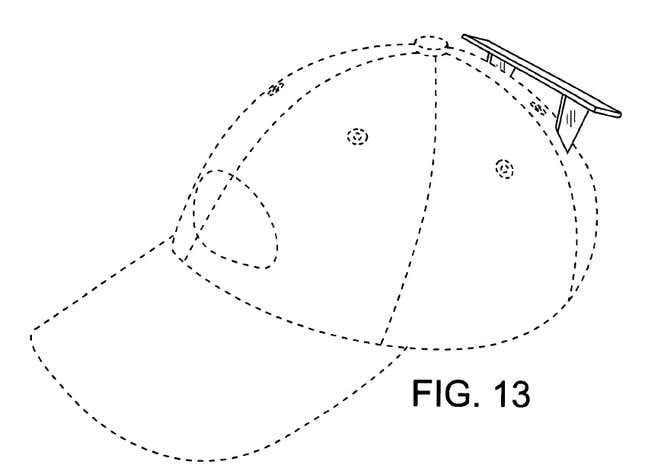
...and match, Bernoulli.
Bring Back Anthony Mason does patent-related stuff in New York. He does not actually think the Knicks should bring back Anthony Mason, at this point.
Top image by Sam Woolley